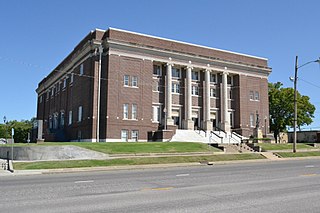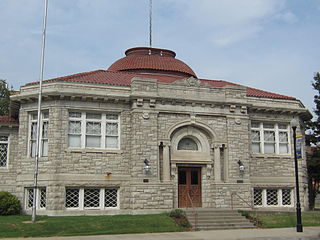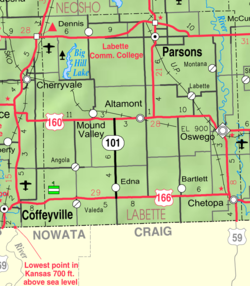
Montgomery County is a county located in Southeast Kansas. Its county seat is Independence, and its most populous city is Coffeyville. As of the 2020 census, the county population was 31,486. The county was named after Richard Montgomery, a major general during the American Revolutionary War.

Osage County is a county located in the U.S. state of Kansas. Its county seat is Lyndon, and its most populous city is Osage City. As of the 2020 census, the county population was 15,766. The county was originally organized in 1855 as Weller County, then renamed in 1859 after the Osage tribe.

Neosho County is a county located in Southeast Kansas. Its county seat is Erie. As of the 2020 census, the county population was 15,904. The county was named for the Neosho River, which passes through the county.

Labette County is a county located in Southeast Kansas. Its county seat is Oswego, and its most populous city is Parsons. As of the 2020 census, the county population was 20,184. The county was named after LaBette creek, the second-largest creek in the county, which runs roughly NNW-SSE from near Parsons to Chetopa. The creek in turn was named after French-Canadian fur trapper Pierre LaBette who had moved to the area, living along the Neosho River, and marrying into the Osage tribe in the 1830s and 1840s.

Altamont is a city in Labette County, Kansas, United States. As of the 2020 census, the population of the city was 1,061.

Chetopa is a city in Labette County, Kansas, United States. As of the 2020 census, the population of the city was 929. Chetopa was named for Chief Chetopah, an Osage Indian chief. Later, the community name was shortened.

Oswego is a city in and the county seat of Labette County, Kansas, United States, and situated along the Neosho River. As of the 2020 census, the population of the city was 1,668.

Parsons is a city in Labette County, Kansas, United States. As of the 2020 census, the population of the city was 9,600. It is the most populous city of Labette County, and the second-most populous city in the southeastern region of Kansas. It is home to Labette Community College and the Parsons State Hospital & Training Center.

Cherryvale is a city in Montgomery County, Kansas, United States. As of the 2020 census, the population of the city was 2,192.

Davis station is an underground Massachusetts Bay Transportation Authority (MBTA) Red Line rapid transit station located at Davis Square in Somerville, Massachusetts. The accessible station has a single island platform for the Red Line, as well as a dedicated busway on the surface. It opened in 1984 as part of the Red Line Northwest Extension project.

The Bender family, more well known as the Bloody Benders, were a family of serial killers in Labette County, Kansas, United States, from May 1871 to December 1872. The family supposedly consisted of John Bender, his wife Elvira, their son John Jr., and their daughter Kate. Contemporary newspaper accounts reported that the Benders' neighbors claimed John Jr. and Kate were actually husband and wife, possibly via a common-law marriage.

Labette Community College (LCC) is a public community college in Parsons, Kansas, United States. LCC's main campus is situated in Parsons and satellite campuses are located in Cherokee, Oswego and Pittsburg. The mascot of the school is Chris the Cardinal. The official school colors are red and white.

Oswego Community Hospital (OCH) was a federally and state-designated 12 bed critical access hospital located in Oswego, Kansas, and one of several hospitals that fell victim to an alleged fraudulent billing scheme that the U.S. Department of Justice says was executed by EmpowerHMS, the hospital's former operator.

U.S. Route 59 (US-59) is a part of the U.S. Highway System that runs from the Mexico–US border in Laredo, Texas, as a continuation of Mexican Federal Highway 85D north to the Lancaster–Tolstoi Border Crossing on the Canada–US border, where it continues as Manitoba Highway 59. In the U.S. state of Kansas, US-59 is a main north–south highway that travels from Chetopa to Atchison.

Skiddy is an unincorporated community in Morris County, Kansas, United States.

William DeBoice Atkinson was a justice of the Kansas Supreme Court from January 1, 1904, to December 1, 1904.

K-101 is a ten-mile-long (16 km) state highway in Labette County in the U.S. state of Kansas. The southern terminus is at U.S. Route 166 (US-166) south of Edna, and the northern terminus is at US-160 west of Altamont. K-101 mostly passes through farmland except the section within Edna.

Kansas's 15th Senate district is one of 40 districts in the Kansas Senate. It has been represented by Republican Dan Goddard since 2017; Goddard lost renomination in 2020 to Virgil Peck Jr.

Ella B. Ensor Wilson was an American social reformer and writer of the long nineteenth century associated with the women's suffrage and temperance movements. She was a strong advocate of "equal rights" and although her birthplace was in Maryland, a slave State, and having been reared and educated under that influence, she was always opposed to slavery. Wilson supported women's causes with her influence and money. A year and a half before her death, she was declared insane.





















